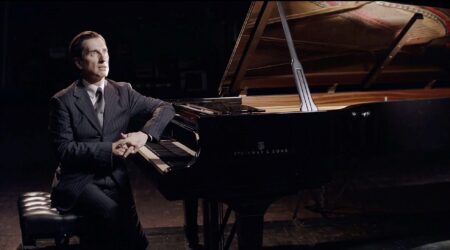The Audacity of Hate: A Review of A Film Unfinished
There are two kinds of audacity. The first definition given in the New Oxford American Dictionary is “the willingness to take bold risks,” as in The Audacity of Hope. The other is “rude or disrespectful behavior; impudence.” A Film Unfinished, a new “documentary” by Israeli filmmaker Yael Hersonski, is a study of the latter, a […]
 There are two kinds of audacity. The first definition given in the New Oxford American Dictionary is “the willingness to take bold risks,” as in The Audacity of Hope. The other is “rude or disrespectful behavior; impudence.” A Film Unfinished, a new “documentary” by Israeli filmmaker Yael Hersonski, is a study of the latter, a chronicle of the mindset that led the German people to force Jews into uninhabitable ghettoes on their way to extermination camps and then somehow find it in themselves to convince the world that genocide was the result of the victims’ greed and their absence of “Kultur.” It would be naive to insist that this outlook did not in some way develop from the bold, risk-taking initiative of the leaders of the Third Reich, whose audacity convinced a great and civilized nation to buy into their vision of a new and better world. More meta-film than documentary, A Film Unfinished subverts the notion of nonfiction by exploring the connection between propaganda and fact, and how easily the two can be conflated and confused in the film medium.
There are two kinds of audacity. The first definition given in the New Oxford American Dictionary is “the willingness to take bold risks,” as in The Audacity of Hope. The other is “rude or disrespectful behavior; impudence.” A Film Unfinished, a new “documentary” by Israeli filmmaker Yael Hersonski, is a study of the latter, a chronicle of the mindset that led the German people to force Jews into uninhabitable ghettoes on their way to extermination camps and then somehow find it in themselves to convince the world that genocide was the result of the victims’ greed and their absence of “Kultur.” It would be naive to insist that this outlook did not in some way develop from the bold, risk-taking initiative of the leaders of the Third Reich, whose audacity convinced a great and civilized nation to buy into their vision of a new and better world. More meta-film than documentary, A Film Unfinished subverts the notion of nonfiction by exploring the connection between propaganda and fact, and how easily the two can be conflated and confused in the film medium.
This a circular (rather than linear) story that begins in 1954, when East German archivists found four reels of a film labeled “Das Ghetto” in an enormous wartime film storage vault. Shot inside the Warsaw Ghetto in 1942 by a German film crew, the raw footage seemed to capture the everyday life of its inhabitants, focusing particularly on the economic and social disparities between the wealthy and the destitute. The unfinished film was long presumed by film scholars to be an accurate account of the ghetto and its complex internal structure, until another reel was found in 1998 consisting of outtakes from the shoot. The missing reel showed the filmmakers clearly manipulating their subjects and their environment until they achieved a desired effect, often shooting several takes of the same scene from different angles while giving directions to the actors.
Hersonski, whose grandmother was a survivor of the Warsaw Ghetto, further complicates the story by filming other survivors watching “Das Ghetto” and reacting to the footage in reliably affecting ways. As the footage begins, one survivor rhetorically asks, “What if I recognize someone I know?” Another talks of having tripped and fallen over a corpse on the sidewalk, landing face-to-face with the body. She immediately rushed home and told her mother about the incident, who comforted her daughter’s tears by giving her a piece of bread with jam, as any concerned mother might do to heal the pain of a scraped knee or being teased at school. Yet we feel her hunger, and it feeds us all. Like the film, there is so much to this story.
Indeed, among the more gruesome things they and the viewer of A Film Unfinished will see are corpses riddling the crowded ghetto streets, which are often used as props by the filmmakers. At one point the body of an older man is picked up, dragged across the pavement, and repositioned at a more advantageous angle and location. The filmmaker then instructs a prosperous-looking Jewish woman to walk across the camera, ignoring his lifeless body. The fifth reel shows that several takes were used for this scene. Another scene shows dozens of bodies being discarded into a mass grave, where workers arrange the corpses in rows to maximize the efficiency of the space, as neatly attired Jews look on without betraying any emotion. These scenes are contrasted with the elaborate, even gaudy funeral rites and gatherings of the seemingly wealthier ghetto inhabitants, including a massive funeral procession through the streets of the Warsaw Ghetto. Like much of the footage shot by the Germans, the images of brutality and despair are all too real, while the appearance of luxury and wealth are a hoax. The interviews with the survivors, plus our own sense of decency and common sense, make it clear that no one inside the ghetto except the Nazis themselves could arrange anything so extravagant.
The words of two other notable commentators involved with the making of “Das Ghetto” are included in the film: German cameraman Willy Wist, and Adam Cherniakov, head of the Warsaw Ghetto’s Jewish Council. Cherniakov, a leader of the community, kept a scrupulous account of daily affairs inside the ghetto, including the visit of a German film crew shortly before the massive deportations of his community to the concentration camps began in earnest. His notes reveal the filmmakers commandeering his apartment to shoot completely fictional scenes and importing massive amounts of champagne into the ghetto for a ball thrown and filmed by the crew.
Wist was the only member of the film crew ever to be identified, found long after the war selling scrap metal, having left the film industry immediately after the collapse of the Third Reich. Testifying at a trial involving the film, he comes off as a disconcertingly sympathetic man, lucid, humble, and seemingly genuine in his remorse over his small role in the destruction of the Jews. In an interesting (and not completely justified) creative decision, Hersonski chooses to recreate his testimony. Played by the excellent German actor Rüdiger Vogler, the director stages history in much the same way as the makers of “Das Ghetto,” with equally ambivalent results. Other fictional touches in A Film Unfinished include the inconspicuous addition of sound to the silent film reels and recreations of the original discovery of the footage. Though compelling throughout and rigorously researched and executed, the fictional elements of her methodology are confusing and go unaccounted for by Hersonski.
Intended to challenge the viewer’s notion of what constitutes reality in front of the lens, A Film Unfinished explores the gap between passive perception and critical analysis, and how this can result in a lacuna in the historical record. The film doesn’t answer every question about the Warsaw Ghetto experience, nor does it intend to. But by casting a focused, dispassionate eye on one small, misunderstood aspect of the HaShoah, Hersonski reveals that there is still much to be learned about and from that part of our collective past.
Researchers and viewers took the footage in “Das Ghetto” at face value for decades, seeing the economic and social disparities portrayed in the film as a fact of life in the Warsaw Ghetto. The film was meant to be part of a massive, concerted Nazi propaganda effort to justify their treatment of Jews by portraying them as greedy, filthy, inhumane animals, undeserving of our sympathy. Even without this film, they were fabulously successful in their goal, and continue to be so today. A Film Unfinished is necessary not just for the continuing study and exploration of the Holocaust, but to remind us to always remain vigilant when confronted with state lies, gratifying propaganda, the utter nonsense of television news, government sanctioned rumors, opinions disguised as facts, advertisements masquerading as truth, and the other innumerable forms of deceit that confront us every day of our lives.
Oleg Ivanov is a freelance writer and theater artist based in New York City. Among other interests, he hates orphans, the homeless, and people who say “aks” and “bro.”





